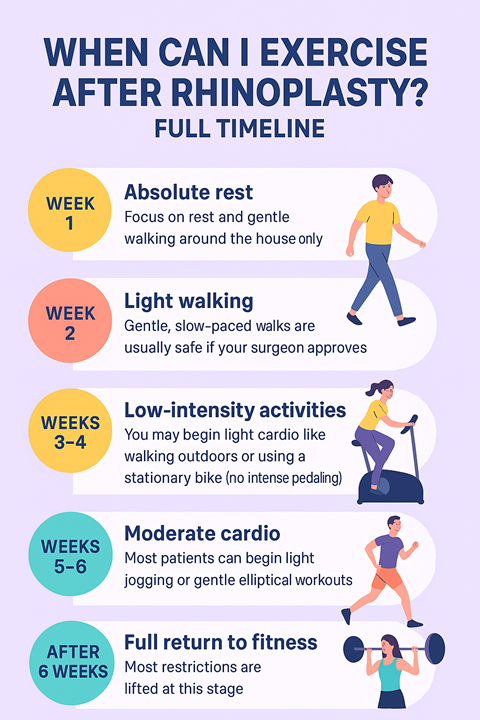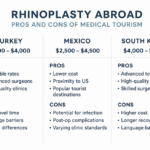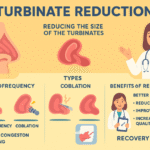You’re two weeks post-rhinoplasty. The splint came off yesterday. Swelling’s going down. Physically? You feel pretty good—honestly, energetic. Your body’s practically begging to move after weeks stuck inside, and that gym membership suddenly doesn’t feel like a waste anymore. But here’s the thing: when can you actually get back to exercising without potentially messing up everything you just paid for? And more importantly, when is it safe?
This question is frustratingly specific. One surgeon tells you light exercise at two weeks. Another wants you to wait four. Your friend who had the same procedure was running at three weeks (somehow), but you’ve read online that two months is safer. The variation in advice feels random, and that’s… kind of anxiety-inducing when you just made a major surgery investment.
Here’s the reality though: these timelines aren’t just random surgeon preferences. They’re based on how your tissues actually heal, what goes wrong at different recovery stages, and what your body can realistically handle. Surgery complexity matters. Your personal healing speed matters. Whether you’re doing this for the first time or it’s a revision makes a difference. Even your pre-surgery fitness level plays a role. That’s why you hear different recommendations—they’re not all wrong; they’re just tailored differently.
This guide breaks down the evidence-based timeline for returning to exercise after rhinoplasty, organized by what you actually want to do (run? lift? do yoga?) and when it’s genuinely safe. Think of it as your roadmap from post-op couch-sitting back to feeling like yourself athletically.
Why You Actually Have to Wait: Understanding the Real Risks
Before we get into the timelines, it’s worth understanding why you can’t just hop back into the gym. These aren’t arbitrary rules—there’s actual biology behind them.
Increased Blood Pressure = Bleeding
Here’s what happens: exercise raises your blood pressure and gets your heart pumping. More blood flow means more blood going to your face. During early recovery, your blood vessels are still healing—they’re basically patching themselves up. That’s when problems start:
What can happen:
- External bleeding from your incisions (the obvious one)
- Internal bleeding, where blood pools inside (that’s a hematoma)
- Nosebleeds
- Persistent oozing from where the surgeon worked
Why it matters: Bleeding sounds minor, but it isn’t. A hematoma might need drainage. It makes swelling way worse. Severe bleeding can honestly damage the surgical work your surgeon just carefully did. And you don’t want that.
When it’s riskiest: The first week or so is the danger zone. But honestly? Elevated risk sticks around through weeks 3-4. After that, things improve significantly.
Your Heart Pumping Harder Means More Facial Puffiness
Vigorous activity cranks up your circulation and body temperature. Both of those things make swelling worse—a lot worse.
The actual impact:
- Exercise can add days or even weeks to how long you look puffy
- Makes it harder to see what your actual results look like
- Creates discomfort
- Puts unnecessary pressure on stuff that’s still healing
Why timing matters: Some swelling after rhinoplasty is unavoidable. But exercise-induced swelling? That’s totally preventable. Why add extra puffiness on top of what’s already happening?
Physical Impact Can Damage Your Freshly Repositioned Structures
Your nose just got restructured. The cartilage’s in a new position. The bone was reset. Everything’s different from before. Now imagine jumping, or something jarring, or an accidental impact. That’s when things go sideways.
The risk:
- Cartilage grafts can shift
- Bone alignment can change
- Structures that are healing can actually break again
- Asymmetry can develop
- Basically, you can undo what your surgeon accomplished
Most vulnerable period: Weeks 1-6 especially. Even at week 8, things are still stabilizing.
Straining and Breath-Holding Increase Nasal Pressure in Bad Ways
This one’s particularly important if you lift. Heavy lifting combined with breath-holding (that Valsalva thing people do without realizing) creates dramatic internal pressure in your nose.
Why that’s bad:
- Can trigger bleeding
- Disrupts the internal healing process
- Can dislodge grafts or sutures
- Creates septum issues
The rule: Avoid straining and holding your breath for at least 4-6 weeks minimum.
Timeline: Week by Week (What You Can Actually Do)
Here’s how it actually plays out, from surgery day through getting back to normal training.
Days 1-7: Walking Only
✓ You can do:
- Gentle walking around your house
- Short walks outside (think 10-15 minutes, flat terrain, not hills)
- Regular daily stuff
- Super light stretching (arms and legs—nothing where your head’s pointed down)
✕ Don’t even think about:
- Any other exercise
- Bending over (increases facial pressure)
- Lifting anything heavier than 10 pounds
- Straining in any capacity
Honest reality: You’ll probably feel capable of more. Your brain’s recovered faster than your tissues have. That gap between “I feel okay” and “my nose is ready” is frustrating as hell. But stick with it.
Weeks 2-3: Adding Light Cardio (Carefully)
✓ New stuff you might be able to do:
- Stationary bike—low resistance, easy pace
- Elliptical—nothing aggressive
- Slow treadmill walking (inclines are fine, but no running yet)
- Very gentle yoga, as long as you’re not upside down
Guidelines if you’re doing light cardio:
- Keep your heart rate under 120 bpm
- Stick to 15-20 minutes initially
- The second you notice bleeding, extra swelling, or discomfort, stop
- Skip high-intensity intervals entirely
Weeks 3-4: Moderate Cardio Gets the Green Light
✓ What’s newly allowed:
- Running—start gentle: 10-15 minutes, easy pace, flat ground
- Outdoor cycling on smooth routes (skip the pothole-filled roads)
- Swimming if incisions are totally healed and surgeon approves
- Elliptical at moderate intensity
- Regular yoga (still no inversions)
How to approach moderate cardio:
- Build intensity and duration gradually
- Start 15-20 minutes, work up to 30-45 over the week
- Keep heart rate around 140-150 bpm max
- Watch for increased swelling
Weeks 4-6: Light Weightlifting Can Start
✓ What you can now do:
- Light weights—upper body: 5-15 pounds depending on what you normally lift
- Lower body resistance work (bodyweight squats, lunges, or light weights)
- Resistance bands
- Core exercises that don’t increase facial pressure
- Moderate-intensity cardio classes (spin, step aerobics)
Weightlifting guidelines if you’re starting:
- Begin with 40-50% of what you lifted pre-surgery
- More repetitions, less weight (that’s the formula)
- Keep breathing continuously—never hold your breath while exerting
- Stop well before failure (no straining)
- Increase gradually over weeks
Weeks 6-8: Heavy Lifting and Serious Training
✓ What’s typically allowed now:
- Your pre-surgery weightlifting routine (but build back into it)
- Heavy compound lifts—squats, deadlifts, bench press
- High-intensity interval training
- CrossFit-style workouts
- Plyometrics (jumping, burpees)
- Most recreational sports (with ongoing awareness about impact)
Weeks 8-12: Contact Sports and Full Athletic Freedom
✓ What’s allowed:
- Contact sports—football, basketball, martial arts, boxing, whatever
- Competitive athletics
- Basically anything without restrictions
The requirement: Get explicit surgeon clearance before contact sports. Some surgeons want you to wait until 12 weeks or even longer.
Activity-Specific Questions (The Practical Stuff)
Running & Jogging
Timeline:
Week 2: Treadmill walking
Week 3: Light jogging
Week 4: Moderate running
Week 6+: Long distance running
Swimming
Timeline:
Week 3-4: Generally safe
Week 6: Conservative option
Note: Diving prohibited until fully healed
Yoga
Timeline:
Week 2-3: Gentle, no inversions
Week 4: Moderate yoga
Week 6+: Hot yoga
Week 8-12: Inversions OK
Weightlifting
Timeline:
Week 4-5: Light upper body
Week 5-6: Moderate weights
Week 6-8: Heavy lifts
Week 8+: Powerlifting
Cycling
Timeline:
Week 2: Stationary bike
Week 3: Outdoor cycling
Week 8+: Mountain biking
(Fall risk is the concern)
Contact Sports
Timeline:
Minimum: 8 weeks
Typical: 10-12 weeks
Requirement: Explicit surgeon clearance
Signs You’re Actually Ready to Move Forward
How do you know it’s safe to progress? Watch for these.
✓ Green Lights (Keep Going):
- Minimal swelling remaining
- Current activity causes zero pain
- Splints are completely off (external and internal both)
- Your surgeon has explicitly cleared the next level
- No bleeding or discharge for at least two weeks
- You can touch your nose without pain
- Current exercise doesn’t increase swelling afterward
✕ Red Flags (Wait Longer):
- Nose is still visibly puffy
- Current activity hurts
- Any bleeding, even minor, in the past week
- Surgeon hasn’t cleared you yet
- Swelling gets worse after exercise
- Touching your nose is uncomfortable
- Any sensation of pressure or fullness during current activity
The Real Question: “Can I?” vs. “Should I?”
This is the mental part. Just because you physically can do something doesn’t mean you should. Your cardiovascular fitness comes back faster than nasal tissue stability. That gap between “I feel like I could run a 5K” and “my nose is actually ready for that” creates the temptation to push too hard too soon.
Better approach:
Follow the conservative timelines. When in doubt, wait another week. Worst case? You lose a tiny bit of fitness (recoverable). Best case? You avoid complications that could set you back months (not recoverable).
What Actually Happens If You Go Too Hard Too Soon
Understanding consequences helps keep you motivated to follow the rules. Really.
Immediate Problems
Bleeding:
Can restart. Might need medical intervention. Causes hematomas. Adds to recovery timeline.
Major swelling increase:
Can add 1-2 weeks to visible puffiness.
Pain and discomfort:
Signals tissue trauma.
Longer-Term Complications
- Structural damage: Premature impact can shift cartilage or bone. Creates asymmetry. Might need revision surgery.
- Prolonged healing: Repeatedly stressing tissues before they’re ready extends total recovery time.
- Compromised results: Worst case? You actually undo surgical improvements.
- More complications: Increased infection and healing problem risk.
The Math
What you risk:Permanent changes to your outcome, extended recovery, potential revision surgery (expensive), serious complications.
What you gain:Going back to exercise 1-2 weeks early, maintaining marginally better fitness.
The calculation’s pretty straightforward. Patience protects your investment.
Special Situations and Questions People Actually Ask
“I’m an Athlete—Can I Recover Faster?”
Nope. Pre-surgery fitness doesn’t speed up tissue healing. Your cardiovascular system might be ready before your nose is, but biology operates on its own timeline regardless of athletic status.
What does help: Athletes often have better body awareness and the discipline to follow protocols exactly. Use that to your advantage—it’s real.
“My Surgeon Said Week X, But I Read Week Y Online”
Follow your surgeon’s guidance. They know:
- Your specific surgical details
- How your healing is progressing
- Individual factors affecting your timeline
Online timelines (including this one) are frameworks, not prescriptions. Your surgeon’s instructions win.
“Can I Just Do Light Exercise Without Permission?”
No. Get clearance before progressing. “Light” is subjective and you might underestimate what you’re actually doing.
“I Exercised Too Soon and Nothing Bad Happened”
You got lucky. Lucky doesn’t mean no damage occurred. Subtle shifts in cartilage or bone might not be visible immediately but can affect final results down the road.
“I Have a Physically Demanding Job—What Do I Do?”
Talk about this during pre-surgery planning. You might need more time off than standard recommendations. Manual labor counts as exercise from a tissue-stress perspective.
How to Return Safely When You’re Cleared
Once you get the green light, come back smart.
Start Lower Than Your Actual Capabilities
Begin at 50-60% of pre-surgery intensity. Your nose needs gradual loading even when cleared.
Increase Gradually Over Weeks
Add 10-15% per week maximum. Slow progression lets you catch problems before they’re serious.
Watch for Warning Signs
Increased swelling? Any bleeding? Pain? Pressure sensations? Those mean you’re doing too much.
Stay in Touch with Your Surgeon
Report concerns at follow-ups. They can adjust recommendations based on your actual healing.
Consider Protective Equipment
Once cleared for contact sports, extra protection (face shields, custom guards) is worth it.
Remember: Final Results Take Time
Even when fully cleared (week 8-12), final results take 12-18 months. Protect your nose from trauma indefinitely.
The Reality: Patience Actually Pays Off
Light walking immediately after. Light cardio at 2-3 weeks. Moderate cardio at 3-4 weeks. Weightlifting at 4-6 weeks. High-intensity training at 6-8 weeks. Contact sports at 8-12 weeks. Always with surgeon clearance.
These timelines exist because tissue healing follows biological stages. You can’t rush biology. Your nose might feel fine at week 2, but structurally it’s nowhere close to ready for intense activity. The gap between feeling capable and actually being ready requires patience.
Yeah, the restrictions suck for active people. Watching your fitness decline while stuck in recovery feels counterintuitive. But exercise too soon and you’re looking at complications that extend recovery far longer than waiting a few extra weeks would have.
Your rhinoplasty represents serious money and emotional investment. Respect that investment by actually following exercise restrictions. Build gradually when cleared. Communicate with your surgeon. And remember: temporary patience creates permanent results.
The workout isn’t going anywhere. But if you damage your nose pushing too hard too soon, you can’t just undo that and try again.


